The
Quakers Meeting House, St. Margaret`s Street, Bradford on Avon
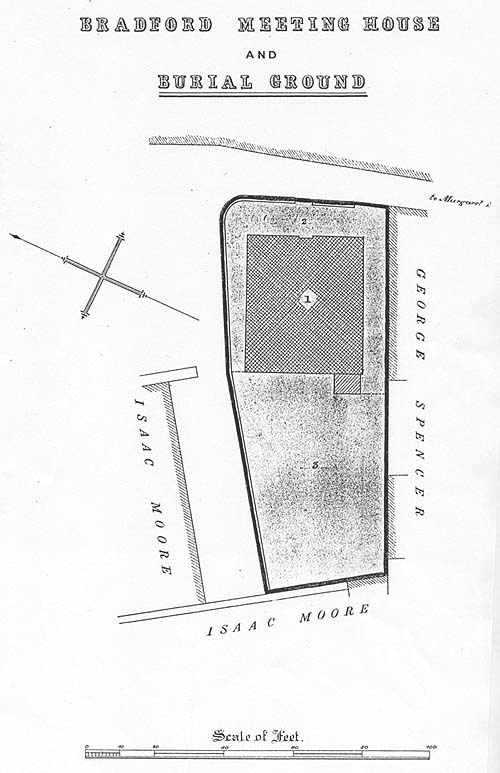
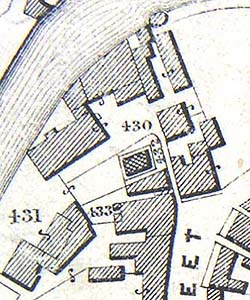
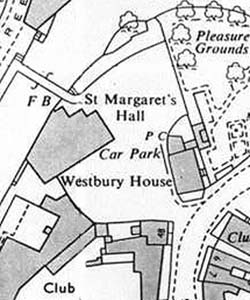
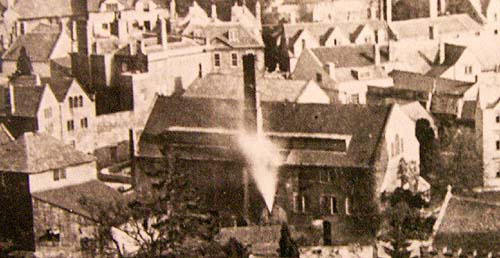
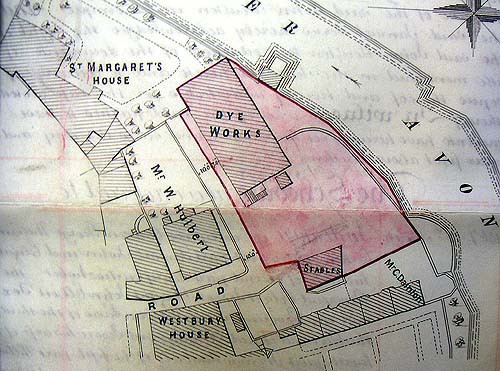
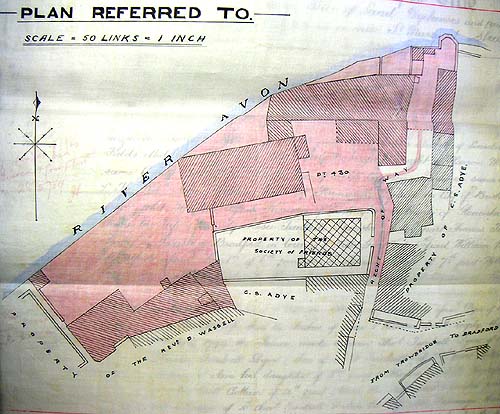
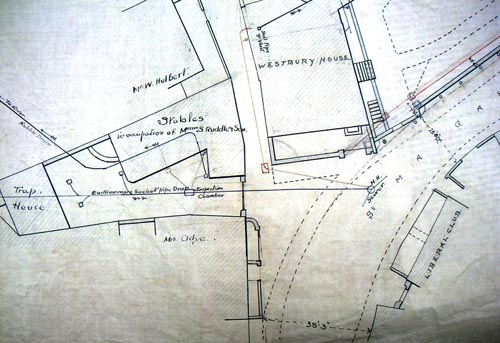
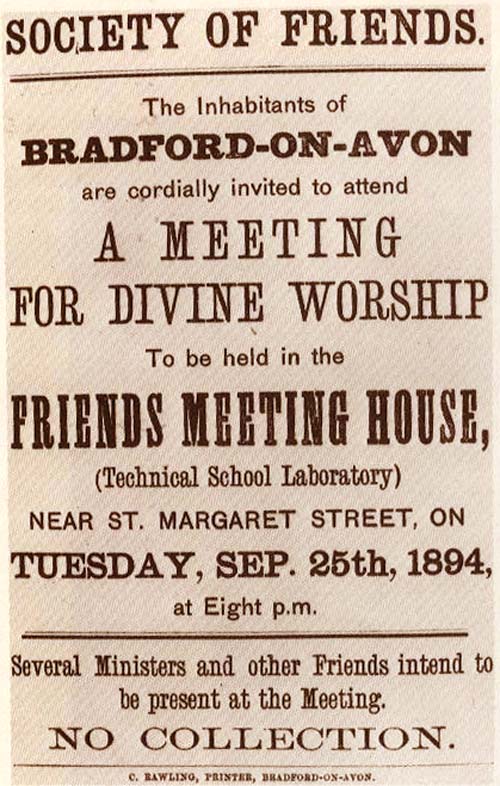
This stood adjacent to what is now St. Margaret's Hall. The site is now part of the public car park. The building was demolished in the early 1960s.
1718 Meeting house erected. A plan drawn in 1867 is attached. 1798 One member only left.
1800 The meeting house was "bounded on the north and east by a
drying ground belonging to Charles Trimnell Timbrell and on the south by tenements belonging to Joseph Phelps and on the west by a dwelling house belonging to the said Charles Trimnell" (WRO 85V39) •
1803 Last recorded burial (Ann Eyles of Bradford, wife of James, aged 81).
1806 Formal agreement to lend the premises as a school for the education of poor children (WRO 85V37)-
1809 "The floods last winter having thrown down most part of the walls round Bradford meeting house" Charles Timbrell, whose property was "contiguous" to the burial ground shared the cost of repairing them (WR085V13 and WRO
1809 Memorandum dated 12 June signed by Charles Timbrell permitted him to mow the grass in the graveyard and keep the yard tidy, it being "contiguous" to his property (WRO
1817) Formal agreements with Charles Cadby and others to use as a 1825) British School (WRO 854/37)
1832 British School agreement renewed with Ezekiel Edmonds, Charles Cadby and William Taylor. (WRO
1848 Agreement dated 7 November renewing the British School agreement at £1 per annum. (WRO 85V37)
1880 Local press report dated 25 September states.- that the Board
of Education has condemned the building as inadequate and that the school will be closed shortly. ("March of Time" item in the Wiltshire Times of 26 September 1980).
1885 A (Quaker) Committee of .Inspection described a "... forlorn and dilapidated look ... burial ground shows no trace of its ancient use ... low wall much broken on two sides ... place. is used as a wool warehouse and the yard as a poultry run ... let at £6 per annum." (Report by William Pumphrey - WRO 85V37)
1895 Report by Samuel Alexander and Norman Penny:- "... capable of seating quite 200 persons ... not in good condition. The roof is leaking ... It is let to be used as a technical art school". (Minute book of North Somerset and Wiltshire Monthly Meeting - WRO 1699A2).
1902 Property sold on 31 July for £80. (WRO 1699A3)
1952 Used as a builder's store. (Victoria County History Vol VII)
Early 1960s Demolished to create a car park.
The fees in 1831 were two pence per week, and late that year the committee were able to speak with confidence of the progress that had been made.
"....five months only have elapsed since the commencement of the school on the 21st day of June, at which time there were 180 boys entered on the books. From the above period, the number of boys in attendance has varied from 200 to 140, fluctuating principally during the harvest, and in getting in of the potato crop, to which latter cause the thin attendance of the boys at the present time can be satisfactorily attributed. The committee have every reason to expect, in the course of two or three weeks, the numbers will progressively increase, as was the case at the close of the wheat harvest.
It is with great pleasure the committee allude (o the progress made by the different boys in their learning. At the commencement of the school, there were but twenty boys Out of the number that could write; they are now happy to state that the whole of the classes are able to write the words given out by the monitors from the dictating cards, many of the boys writing a good bold hand. As an encouragement, the committee have presented each of the boys in the eighth class with a copy book,...
The committee are happy to observe that there have been many visitors to the school who have expressed themselves much pleased with the working of the system and the improvement of the boys: to which opinion they most cordially subscribe, and also that the school will be attended with the most beneficial results to the town and neighbourhood."
There was more praise for what was obviously a very popular school the following year, and on the occasion of this, the 1832, Report there were 187 boys present, together with a few girls who could be accommodated because the room was not quite full. It measured 36' x 30' and contained 12 desks of 17 seats each.
"The progress of the pupils appeared to be pretty good; several read fluently, and had obtained considerable scriptural knowledge, who were unable to name tbile tters on their admission. The master stated that an examination of the school before the parents had been very beneficial in increasing the number and in strengthening his hands, by engaging the cooperation of the parents. Although the order of this school did not appear preeminent, yet it is probable that many
I
on visiting it might be ready to subscribe to the following entry which we found written by a gentleman in the visitors' book: 'I have with real heartfelt pleasure visited this school, and rejoice in its excellent order and the deep attention of the children.'"
This entry is from an abridged journal of a visit to British schools in Oxfordshire, Buckinghamshire, and Wiltshire in the British and Foreign School Society Report of 1832. The writers go on to describe their continuing inspection of schools in Trowbridge, Westbury, and Warminster. At Trowbridge, where fees were also two pence a week, there was a school "conducted in a very spirited and efficient manner, under great disadvantages". But Westbury, "in every aspect under which we saw it, presented a deplorable view. Passing through it, we found a number of men loitering about unable to find employment, and the school here formed a sad contrast with the beautiful and interesting establishments we had just visited [in Bradford and Trowbridge]." Warminster was also unsatisfactory in that the visitors were not allowed to question the children about what they had read in the scriptures - "a very material evil".
Back to Bradford. The visitors acknowledged the need for a girls' school in the town, but saw little prospect of one being provided in the near future. "It is with great difficulty that the Committee are enabled to raise subscriptions to give the master any salary above the pence. The place is very poor, and the people dejected in consequence of the removal of the principal cloth factories." Some 20 years or so were to pass before anything could be done for the girls.
Six years later - in 1838 - only 80 boys were in attendance when the school was visited (the harvest or potato picking perhaps again being responsible), but 'it is generally prized by the inhabitants and is under efficient management". Unfortunately, from the 1840s onwards it came under increasing pressure from its more efficient and affluent National neighbours and began the steady decline that led to its eventual closure.
John Marchant was an early Master of the British Boys' School, but for many years in the 1840s, 1850s, and 1860s it was in the hands of John Stapleton. Henry hard and John Lewis were later Masters, and it was during the latter's tenure that, after 74 years, the school ceased to be.
A report of the Education Department, dated 14 July 1880, says:
The ventilation [of the building] is most imperfect; the windows on one side have to be frequently kept closed to exclude the smoke of the neighbouring factory, and on the other side the building is exposed to the effluvia of a rank and confined stable. Altogether, the position is most gloomy and depressing, and unsuited to the purpose, there being no playground but the factory yard, and the building being overshadowed by higher walls on all sides. It would appear therefore that the building is becoming unsuitable for school purposes, and the question of the continuance of the annual grant will have to be considered seriously by their Lordships."
It closed, in fact, in September of that year.
The two British Schools in Bradford on Avon were very much the poor relations as far as both the quality of accommodation and of the instruction they offered were concerned. They did not have the financial resources of their National counterparts. But the old Quaker meeting house survived the closure of the Boys' School and for some years at the end of the century it served as laboratory accommodation for the newly established Technical Institute.